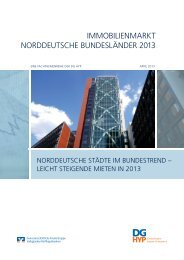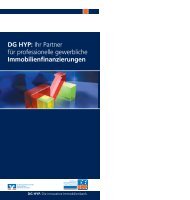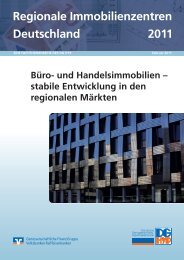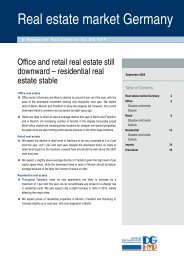ANNUAL REPORT 2006 - DG Hyp
ANNUAL REPORT 2006 - DG Hyp
ANNUAL REPORT 2006 - DG Hyp
You also want an ePaper? Increase the reach of your titles
YUMPU automatically turns print PDFs into web optimized ePapers that Google loves.
RISK <strong>REPORT</strong><br />
I) Risk management – objectives and organisation<br />
a) Objectives of risk management<br />
<strong>DG</strong> HYP’s risk management process is geared towards<br />
exploiting the business potential within the scope of the<br />
bank’s capacity to carry and sustain risk, emphasising profitability.<br />
Within this context, we follow the guidelines of<br />
optimising the risk/return profile of the lending business,<br />
with respect to individual transactions as well as within the<br />
framework of active management of the entire portfolio.<br />
The individual types of risk in the lending and securities<br />
business are standardised to permit comparison, in order to<br />
provide a basis on which capital allocation throughout the<br />
entire bank is managed, with an emphasis on risk and<br />
return.<br />
b) Responsibilities<br />
The organisation and assignment of responsibilities for<br />
<strong>DG</strong> HYP’s risk management is focused on the requirements<br />
of the bank’s business model, within the framework of<br />
applicable regulatory requirements, in particular, the Minimum<br />
Requirements for Risk Management (Mindestanforderungen<br />
an das Risikomanagement – “MaRisk”).<br />
<strong>DG</strong> HYP has also developed and implemented risk management<br />
and risk controlling systems that take into<br />
account all market and competitive requirements. This<br />
forms the basis that ensures the proper operation and<br />
efficiency of the risk management process.<br />
Management Board. All members of the Management<br />
Board are jointly responsible for risk management<br />
at <strong>DG</strong> HYP. The Management Board determines the risk<br />
policy with regard to defining the business and risk<br />
strategies, determining the types of business pursued, and<br />
defining the justifiable overall risk level, in line with the<br />
bank’s capacity to carry and sustain risk.<br />
Risk/Return Management Committee. The Risk/<br />
Return Management Committee is the central body for risk<br />
management across the entire bank. Besides including the<br />
members of the Management Board as committee members<br />
carrying voting rights, the heads of Finance/Controlling,<br />
Credit Treasury and Treasury are also members of the<br />
Committee, but have no voting rights. The Committee<br />
generally convenes fortnightly, and concerns itself in particular<br />
with the management of the risks of the entire bank<br />
at a portfolio level as well as the allocation of capital.<br />
34 Deutsche Genossenschafts-<strong>Hyp</strong>othekenbank AG | Annual Report <strong>2006</strong><br />
Management Report<br />
Credit Committee. The Credit Committee is responsible<br />
for managing and monitoring all of <strong>DG</strong> HYP’s credit<br />
risks. It comprises the entire Management Board and the<br />
heads of Front Office, Back Office and Finance/Controlling.<br />
The Credit Committee deals with individual credit decisions<br />
and fundamental issues regarding the bank’s lending<br />
business. In addition, the Credit Committee is responsible<br />
for dealing with strategic credit issues. These include, in<br />
particular, the credit risk strategy, current risk events and<br />
risk provisioning, credit portfolio management and income<br />
optimisation as well as credit workflow optimisation.<br />
Risks and Participations Committee of the Supervisory<br />
Board. This Committee comprises up to four of the<br />
bank’s twenty-one Supervisory Board members. It is<br />
responsible for the decision-making regarding certain loan<br />
exposures, portfolio transactions and participating interests<br />
which – in line with the Internal Rules of Procedure – are<br />
not within the remit of the Management Board.<br />
Supervisory Board. The entire Supervisory Board<br />
decides on the acquisition or disposal of participating interests<br />
in the event of changes exceeding € 500,000 in the<br />
carrying amount of such interests, as well as on the<br />
establishment or disposal of business lines, establishing<br />
branches and representative offices, the internal rules of<br />
procedure of the Management Board, the business distribution<br />
plan, and on material issues related to loans or<br />
participations that are not explicitly assigned to the Risk<br />
and Participations Committee of the Supervisory Board.<br />
c) Functions<br />
Risk Planning. Planning, as a bank-wide exercise,<br />
comprises the planning of income and costs, as well as<br />
the risks associated with <strong>DG</strong> HYP’s individual business<br />
activities. Based on the strategic business orientation as<br />
part of a 5-year plan, the bank carries out operative<br />
planning on an annual basis. Within this planning process,<br />
risk limits and earnings projections are determined in<br />
the respective business units on the basis of the bank’s<br />
capacity to carry and sustain risk.<br />
Risk Management. Risk Management is structured in<br />
line with the front office. As part of the credit risk strategy<br />
defined in each case, the credit risk management departments<br />
are responsible for managing the risk of counterparty<br />
default for an individual exposure and at portfolio level.<br />
This comprises both the implementation and active management<br />
of provisions within the scope of the credit risk














